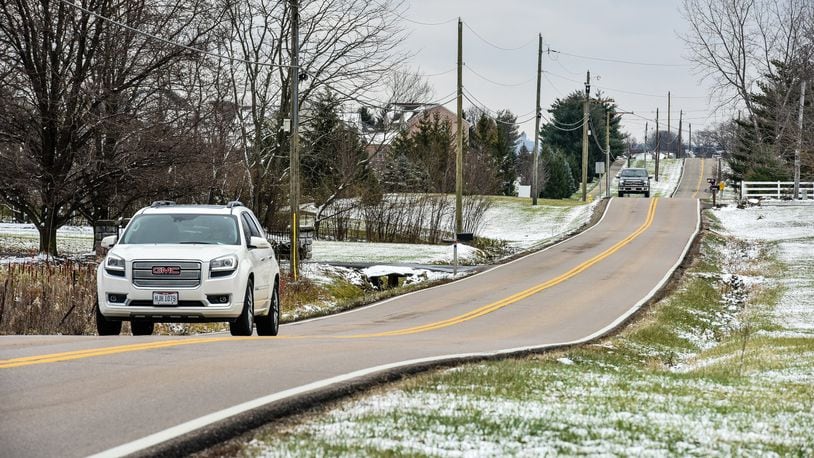“The projects are competitive based…,” Wilkens said. “One of the key components that helps push you over the edge is what your local match is — it is usually a minimum of 20 percent — but you get points the more you contribute at the local level.”
The county’s two largest townships — the county engineer doesn’t work on roads in cities or other incorporated areas — Liberty and West Chester usually have the bulk of the big projects because they have the tax increment financing (TIF) and Residential Incentive District (RID) revenue to contribute.
RELATED: Butler County airport project under budget
These TIF districts are an economic development tool that many local governments use to encourage new investment in an area. A district typically surrounds a parcel or group of parcels and enables the taxpayers within it to make payments into a special fund in an amount equal to their property tax liability for the life of the TIF. These payments in lieu of taxes are used by the local governments to retire debt incurred for the infrastructure improvements — such as roads and water and sewer lines — needed to support current and future development in the area of the TIF.
The biggest grant received in 2017 and 2018 was $5.8 million for the $7.3 million Ohio 747 road widening project in Liberty Twp. that was completed this year. The township made up the difference using TIF/RID funds.
The trustees there just approved another big project Tuesday that is apparently not grant-worthy. Trustee Steve Schramm said he wanted to wait a year or two to address the $2 million project to make Princeton Road between Cincinnati Dayton and Butler Warren roads safer, in hopes of finding grant money.
Cars have tipped off the curved road into the ditch because there are no berms or much of a shoulder, but safety isn’t the only consideration. Traffic counts more.
“The feeling from the staff and the county was we have enough of a safety issue on that road that we can’t run the risk of waiting a whole lot longer,” Schramm said. “The grant money we could potentially get would just be offset by the increase in costs of what it would be a year from now or two years from now, to do it.”
Finance Director Michelle Greis said the township will fund the Princeton Road project half with capital improvement money and the rest out of the Joint Economic Development District fund. Liberty budgeted $2.4 million last year, $4.3 million this year and $3.1 million next year for TIF/RID projects and debt service. Greis said in the seven project and five debt service funds the balance is $5 million.
One of the biggest projects on the horizon is coming next year when West Chester Twp. installs a diverging diamond design at the Union Centre Boulevard interchange over Interstate 75. The project estimate is $13 million and will be paid entirely out of TIF funds.
With an estimated 49,000 cars a day traveling between Muhlhauser Road and the Union Centre Blvd. interchange, Trustee Mark Welch said they couldn’t wait to ease the congestion at the critical location.
“That entire area had grown up so fast it was like an explosion and the traffic was really getting out of hand…,” Welch said. “The traffic was what we considered such a problem that we felt like we couldn’t wait for the process to go through for a grant. It was going to be more than just a few years.”
MORE: Butler County road work hits the brakes for winter
The township received $21 million in payments in lieu of taxes into the TIF fund this year — paid about $4.2 million to the schools — in six project and three debt service funds ties to TIF. The balance in all those funds is $65.8 million and debt in the funds of $20 million, according to township spokeswoman Barb Wilson.
She said next year the township plans to fund about $5 million worth of projects with the TIF districts that would normally be the engineer’s financial responsibility.
Most townships don’t have the luxury of robust TIF and RID funds to pay for infrastructure. That’s why Ross Twp. will soon be wrestling over whether to put a road levy on the ballot. Township Administrator Bob Bass said they usually budget $200,000 to $300,000 annually for road work — using their portion of gas and license taxes and local money. That funding is enough to keep “good” roads maintained but very soon they will “be struggling mightily” to find money to handle deteriorating roads.
“When the time comes, and it’s coming very quickly, we’re going to have some hard decisions to make,” he said. “I think our only option at this point, due to the fact we don’t have TIFs and RIDs available to us, is we’re probably going to be talking levy.”
He said they will be discussing this issue during upcoming budget talks for 2019. When Gov. John Kasich slashed local government funding and they lost the estate and tangible personal property taxes, 60 percent of their general fund revenue vanished.
“It’s unfortunate that the state, the way they’ve chosen to get themselves out of trouble by using our money has put us in a hole,” he said. “We don’t have any other options.”
Wilkens’ $34 million road, bridge, culvert and paving plan for this year was funded through the grants, local TIFs and some RIDs in Liberty Twp., gas and license taxes. The townships reimburse the engineer for paving — he gets a better price by bidding the entire county — but a lot of the smaller project funding comes out of the engineer’s purse.
Wilkens said all the funding sources combined allow them to just meet the county’s road construction needs.
“It makes us stand a chance of meeting the capacity needs for this county,” Wilkens said. “It keeps us close.”
About the Author
